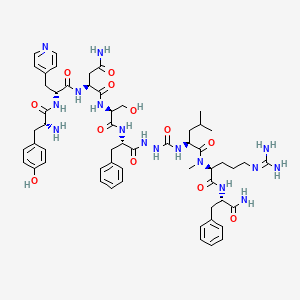|
Name: N-Methyl-3-piperidyl benzilate
Type: Anticholinergic
AKA: JB 336

|
|
II. Natural Derivative
Synthetic substance, no natural derivative
 |
|
III. Chemical Profile (IUPAC name)

|
|
IV. History
N-Methyl-3-Piperidyl Benzilate, a synthetic drug, was first synthesized in the mid-20th century. It was used primarily in research to study its effects and potential applications. Its historical significance lies in its contribution to the development of synthetic drugs and their effects on the central nervous system.

|
|
V. Legal Information
N-Methyl-3-Piperidyl Benzilate is a synthetic compound with sedative effects. It is regulated as a controlled substance in various jurisdictions due to its potential for abuse. In the U.S., its legal status is governed by the Federal Analog Act, which can classify substances with similar effects to controlled drugs. Internationally, its control follows similar patterns, with regulations aimed at curbing its misuse. [Source: UNODC].
US Federal Schedule - I
Schedule I drugs, substances, or chemicals are defined as drugs with no currently accepted medical use and a high potential for abuse. Some examples of Schedule I drugs are: heroin, lysergic acid diethylamide (LSD), marijuana (cannabis), 3,4-methylenedioxymethamphetamine (ecstasy), methaqualone, and peyote.
Key US Federal Policies:
Controlled Substances Act. Public Law: Public Law 91-513 (text can be found on GovInfo) (https://www.dea.gov/drug-information/csa). Date enacted: October 27, 1970.
|
|
VI. Physical Effects
N-Methyl-3-Piperidyl Benzilate, a synthetic anticholinergic, was developed in the mid-20th century. It acts as a downer, causing sedation and cognitive impairment. Physical impacts include dry mouth, dilated pupils, and decreased heart rate. Short-term use can result in effective sedation, but long-term use may lead to cognitive dysfunction and dependence. Overdose risks include severe anticholinergic effects and potential delirium. Safe use involves careful dosing and monitoring. Recent research focuses on its effects on the central nervous system and its safety profile.  |
|
VII. Psychological Effects
N-methyl-3-piperidyl benzilate, an anticholinergic, affects acetylcholine receptors, causing delirium and cognitive impairment. Immediate effects include mood alteration and confusion, lasting several hours. Long-term use can lead to psychological issues such as memory loss and cognitive decline. Research indicates significant mental health risks with chronic use, including severe cognitive impairments and potential for addiction.
 |
|
VIII. Culture
N-Methyl-3-Piperidyl Benzilate is a synthetic compound with no historical lore. It gained significance in the late 20th century as a research chemical. Its cultural impact involves its use in scientific research and discussions about safety and efficacy. Proponents focus on its research applications, while opponents raise concerns about potential misuse and safety. Its use is primarily in research contexts.
 |
